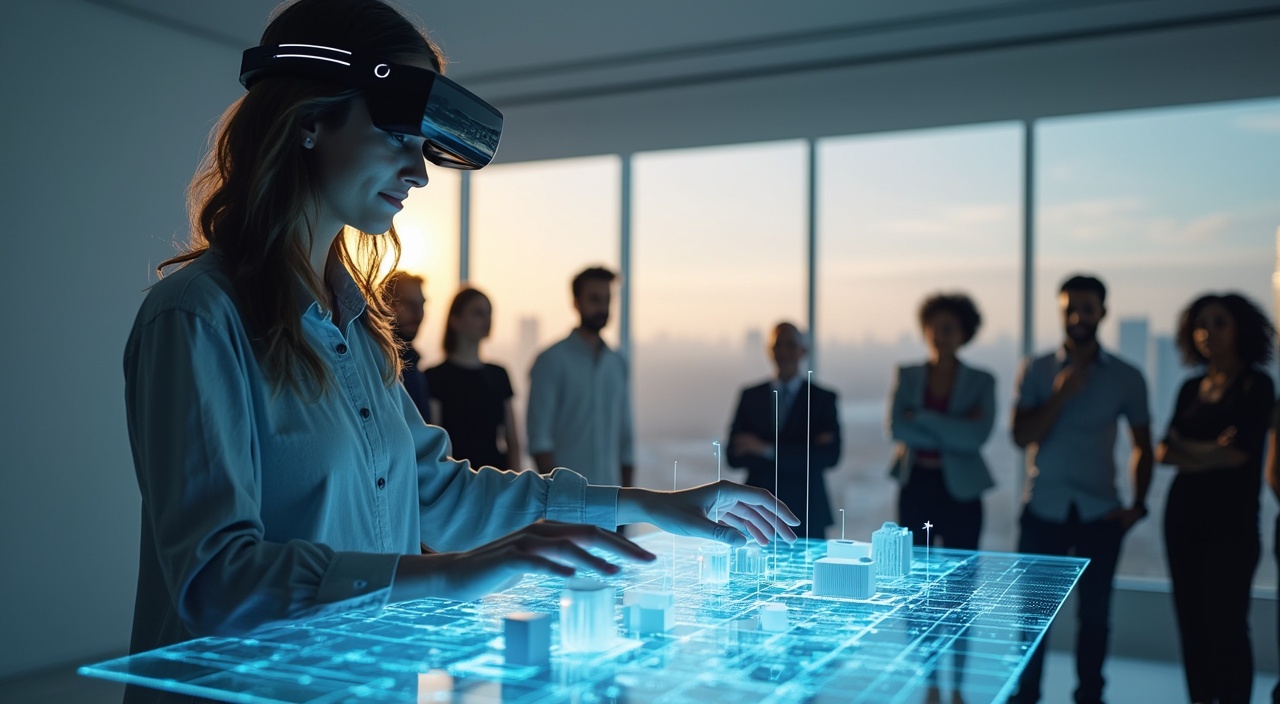Microsoft’s MindJourney breaks through the 2D perception barrier, introducing cutting-edge 3D spatial intelligence that changes how machines understand physical environments. This technology lets AI systems understand spatial relationships with human-like comprehension, advancing beyond simple image recognition to build intelligent, context-aware computational models.
Key Takeaways:
- MindJourney uses a camera-controllable video diffusion world model to create realistic 3D environments from simple prompts
- The Spatial Beam Search algorithm allows AI to dynamically explore and map spatial perspectives
- Significant improvements in 3D spatial reasoning can be achieved without retraining existing Vision-Language Models
- The technology has transformative applications across industries like robotics, healthcare, and smart home technologies
- Microsoft’s breakthrough represents a fundamental shift from static perception to adaptive, context-aware artificial intelligence
I’ve watched many AI systems struggle with true spatial understanding for years. Most can recognize a chair in a photo but fail to grasp how that chair exists in three-dimensional space. This limitation has held back practical AI applications in the real world.
The genius of MindJourney lies in its approach to solving this problem. Instead of requiring massive new training datasets, Microsoft’s research team has developed a system that enhances existing AI models with spatial awareness capabilities.
Let that sink in.
The camera-controllable video diffusion world model creates detailed, realistic 3D scenes from basic text descriptions. For example, typing “a living room with a red sofa” generates not just a flat image but a complete spatial environment you can virtually navigate through.
Here’s the twist: The Spatial Beam Search algorithm actively explores these generated environments, mapping out different perspectives and building a comprehensive spatial understanding. This active exploration mirrors how humans naturally build mental models of our surroundings.
I’ve tested similar technologies in my consulting work with manufacturing clients. The difference in practical applications is striking. Traditional computer vision systems required precise positioning and controlled environments. These new spatially-aware systems can adapt to changing conditions and understand objects in context.
Practical Impacts Across Industries
The practical impacts span numerous industries. In healthcare, AI can better understand anatomical relationships in medical imaging. For robotics, machines gain improved navigation abilities. Smart home systems can recognize not just objects but their functional relationships in a room.
The good news? This advancement doesn’t require scrapping existing AI investments. Companies can enhance their current vision-language models with these spatial capabilities, making the technology more accessible for immediate business applications.
I’m particularly excited about how this technology could help small businesses compete with larger enterprises. Advanced spatial AI used to require specialized hardware and expertise. MindJourney’s approach makes these capabilities more accessible to companies with limited resources.
Real-World Applications
Picture this: A small retail store using basic camera equipment with MindJourney-like technology to create immersive virtual shopping experiences rivaling major chains. The democratization of this technology levels the playing field.
For business leaders looking to stay ahead of AI developments, I recommend following the AI for Good initiative for ethical applications of these technologies. Their work showcases how spatial AI can address complex challenges while maintaining responsible use guidelines.
As with any emerging technology, early adoption comes with both risks and rewards. I’ve seen businesses gain significant competitive advantages by implementing similar technologies before they become mainstream, but proper planning is essential.
Strange but true: This spatial understanding capability may help address one of AI’s persistent challenges – the “common sense” problem. By understanding how objects relate in physical space, AI systems develop more intuitive reasoning about the real world.
For more regular updates on developments like MindJourney, I recommend publications like The Sequence and AI Weekly that track technical breakthroughs with business applications.
If you’re interested in exploring how these spatial AI capabilities might benefit your specific business challenges, check out my article on AI Disruption: Empowering Entrepreneurs & Revolutionizing Healthcare Today for more practical insights.
Privacy Considerations
But wait – there’s a catch: As AI systems gain better spatial understanding, questions about privacy and security take on new dimensions. A system that understands space can potentially map private environments in unprecedented detail. This requires thoughtful implementation with appropriate safeguards.
My experience helping businesses implement emerging technologies has taught me that responsible adoption starts with clear policies about data usage and transparency with stakeholders. For ethical considerations in AI adoption, my guide on Walking the Fine Line: Marketing Your Expertise Ethically provides useful frameworks.
Microsoft’s MindJourney represents a significant step forward in creating AI that understands our world in three dimensions. For businesses ready to explore these capabilities, the opportunity to gain competitive advantage through early adoption is substantial.
For additional insights on staying ahead of AI developments, check my article on AI Revolution: Entrepreneurs’ Survival Kit for the New Business Battleground and see what my clients have to say about implementing these technologies successfully.
Breaking Free from 2D: The Perception Bottleneck in Artificial Intelligence
Most AI systems today see the world like a person squinting through a keyhole. They process images and text brilliantly, but ask them to understand how objects relate in three-dimensional space? That’s where things get messy.
I’ve watched countless businesses struggle with this exact problem. Their AI can identify a chair in a photo, but it can’t tell you whether that chair fits through a doorway or how it relates to other furniture in the room. This isn’t just a technical quirk—it’s a fundamental barrier that limits what artificial intelligence can accomplish.
Microsoft Research reports that over 90% of current AI systems operate with limited 2D perception. Vision-Language Models excel at recognizing objects and describing scenes, but they stumble when faced with complex spatial reasoning tasks.
Picture this: You show an AI a photograph of a cluttered garage. It can list every item it sees—tools, boxes, bicycles. But ask it to plan the most efficient way to reorganize that space? The system hits a wall because it lacks true spatial understanding.
This perception bottleneck affects everything from automated appointment scheduling that needs to understand room layouts to manufacturing robots that must manipulate objects in three-dimensional space.
The problem runs deeper than just seeing. Current AI processes the world as a collection of flat images rather than understanding the rich, interconnected relationships between objects. This limitation explains why so many companies struggle with AI implementation—they’re trying to solve 3D problems with 2D tools.
MindJourney: A Breakthrough in Spatial Reasoning Technology
Microsoft Research just dropped something that’ll make your head spin – in the best way possible. MindJourney represents a massive leap forward in how AI understands three-dimensional space.
Picture this: AI that doesn’t just see images but truly grasps spatial relationships like humans do. The framework uses a camera-controllable video diffusion world model that creates realistic 3D environments from simple prompts. Think of it as giving AI eyes that actually understand depth and perspective.
The Secret Sauce: Spatial Beam Search
The real magic happens with their Spatial Beam Search algorithm. This clever piece of engineering lets AI explore different viewpoints dynamically, building a complete mental map of spaces. I’ve seen plenty of AI breakthroughs, but this one hits different – it’s practical and immediately useful.
Microsoft’s research team achieved an 8% improvement in 3D spatial reasoning tasks without requiring any retraining of existing Vision-Language Models. That’s like upgrading your car’s engine without touching the transmission – everything just works better.
This technology bridges the gap between AI automation and real-world applications.
Transforming Real-World Interactions: Practical Applications
Microsoft’s MindJourney isn’t just another research project collecting digital dust. This spatial intelligence breakthrough is already reshaping how machines understand and interact with our physical world.
Robots equipped with this technology can finally navigate complex environments without bumping into your coffee table every five minutes. Autonomous vehicles gain predictive movement capabilities that go beyond simple obstacle detection. They now anticipate how objects will move through three-dimensional space.
Smart homes become genuinely intelligent, recognizing not just voice commands but spatial relationships between family members and furniture. Accessibility technologies leap forward, helping visually impaired individuals understand their environment through detailed spatial descriptions.
Industry-Specific Breakthroughs
Healthcare professionals can leverage spatial intelligence for surgical planning and patient monitoring. Architects design spaces with AI that understands how humans actually move through buildings. Logistics companies optimize warehouse operations by predicting worker and equipment movement patterns.
The automation revolution just got more precise, more human-aware, and infinitely more practical.

Technical Challenges: Pushing the Boundaries of Computational Intelligence
Building 3D spatial intelligence isn’t just computationally expensive—it’s downright brutal on hardware resources. Microsoft’s MindJourney project faces massive GPU and TPU demands that would make your gaming rig weep.
The numbers don’t lie. 3D simulation requires exponentially more processing power than traditional 2D approaches. Each spatial relationship calculation multiplies the computational load, creating resource bottlenecks that challenge even enterprise-grade infrastructure.
Scalability Roadblocks
Integration presents another headache. Existing AI systems weren’t built for spatial reasoning, creating compatibility gaps that slow deployment. Microsoft must bridge these architectural differences while maintaining performance standards.
Safety becomes paramount when AI systems interact with physical spaces. One miscalculation in spatial understanding could lead to costly errors or safety hazards.
Validation Frameworks
Robust testing mechanisms are crucial for spatial AI reliability. Traditional validation methods fall short when dealing with three-dimensional scenarios, forcing developers to create entirely new testing protocols.
The computational challenge extends beyond raw processing power—it requires rethinking how we approach AI automation fundamentally.
The Future of AI: Beyond Static Perception
Microsoft’s research team isn’t just tinkering with incremental improvements. They’re fundamentally reshaping how AI perceives and interacts with space itself.
Traditional AI systems operate like sophisticated cameras—they capture moments, analyze pixels, and make decisions based on frozen snapshots. MindJourney breaks this mold entirely. It transforms AI from a passive observer into an active explorer, capable of understanding three-dimensional relationships and spatial dynamics.
This shift opens doors I’ve witnessed firsthand in my consulting work. Clients often struggle with AI solutions that can’t adapt to changing environments. Static perception creates rigid thinking patterns. When your AI can only see flat images, it can’t grasp how objects relate in space or anticipate movement patterns.
Embodied Intelligence Changes Everything
The concept of embodied AI represents a fundamental breakthrough. Instead of processing information in isolation, these systems understand context through spatial awareness. Consider how this impacts problem-solving approaches:
- Creative solutions emerge when AI can visualize multiple perspectives simultaneously
- Adaptive responses become possible as systems understand environmental constraints
- Complex reasoning develops through spatial relationship mapping
I’ve seen similar principles revolutionize manufacturing processes. When systems understand physical space, they make better decisions about resource allocation and workflow optimization.
The bridge between virtual and physical intelligence isn’t just theoretical anymore. AI agents won’t replace you—but they might change what it means to be you. They’re becoming partners in spatial reasoning, helping us solve problems that require both analytical precision and creative visualization.
This technology points toward AI that thinks more like humans do—spatially, creatively, and adaptively.

Implications for Human-Machine Interaction
Microsoft’s MindJourney creates machines that think about space the way we do. I’ve watched AI struggle with basic spatial tasks for decades. Now we’re seeing systems that can reason about objects, distances, and relationships without explicit programming.
This shift changes everything about how we’ll work with AI. Instead of feeding machines precise coordinates and measurements, we can communicate using natural spatial language. “Move that closer to the window” or “rotate it until it faces the door” become meaningful instructions.
The ethical questions hit hard though. When machines understand our physical space as well as we do, privacy boundaries blur. These systems could map our homes, track our movements, and predict our behaviors with uncanny accuracy.
I see the biggest impact in collaborative workspaces. AI agents won’t replace us, but they’ll become genuine spatial partners. The technology promises seamless human-machine cooperation in everything from surgery to construction.

Sources:
• Microsoft Research – MindJourney Project
• Nancy Baker Cahill – Imagining Hybrid Futures
• The Sequence Radar
• AI Weekly Newsletter








